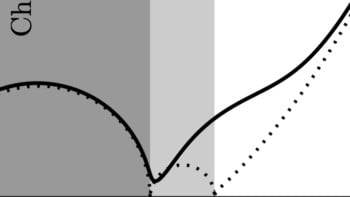An eloquent defence of string theory and a mathematical analysis of luck and chance, reviewed by Margaret Harris

In defence of strings
Joseph Conlon is not one to mince words. In the opening chapter of his book Why String Theory?, he observes that while he and his fellow string theorists are sometimes regarded as “the intellectual equivalents of John Wayne, using the power of pure thought to conquer the untamed territories of physics”, it is also true that “a more recent outlook sees them as surrender monkeys who…fled from experiment for a combination of mathematical arcana and personal wonga”. The truth, he adds, is “more human than the first and richer and more powerful than the second”. Over the next 13 chapters, Conlon defends this thesis with linguistic verve and self-deprecating wit, tracing the history of string theory from its origins in the late 1960s to its present-day applications in (among other areas) quantum field theory. The result is probably the best popularly oriented defence of string theory since Brian Greene’s The Elegant Universe became a runaway bestseller back in 1999, yet in many ways the two books are polar opposites. Greene’s work was published during one of string theory’s periodic upswings, and its confident tone reflected both the times and the personality of its boyish, enthusiastic author. Conlon is no less a wunderkind than Greene (at age 35, he is already a full professor at the University of Oxford), but his authorial style tends towards the wry and British – especially in chapter 7, which covers “Direct experimental evidence for string theory” (it is a very short chapter). He also approaches his subject after more than a decade of intense external scepticism, including the so-called “String Wars” of the mid-2000s. Hence, the prevailing question Conlon addresses is not so much “Is string theory true?” but rather “Is it useful?” The answer he gives is a firm “yes”, and while this may seem like a retreat from the days when string theory was touted as a nascent “theory of everything”, Conlon is a practical sort of theorist. As he puts it, “My interest in string theory is in what it can offer to physics that can be probed by experiment,” and not its mathematical beauty or its potential to reconcile quantum mechanics and gravity. As such, he writes, “String theory [can] be treated as a tool, compatible with an agnostic attitude to its status as the fundamental theory of this world.”
- 2016 CRC Press £19.99/$ 29.95pb 260pp
Lucky chances
In 1993 Joan Ginther won $5.4m in a Texas lottery. Several years later, she won another $2m, followed by $3m in 2008 and $10m in 2010. Was her stupendous success just luck? Or had Ginther – a mathematician by training – somehow found a way of gaming the system? Her story is one of 10 unusual tales to feature in Joseph Mazur’s book Fluke: the Math and Myth of Coincidences. Like Ginther, Mazur is a mathematician, and although he has never won millions in the lottery, he has certainly experienced some very peculiar coincidences – including one time when he bumped into his own brother in a café in Crete, despite neither of them knowing beforehand that the other was on holiday there. But just how unlikely are such occurrences? In the book’s opening chapters, Mazur tells a handful of these coincidental stories, places them into categories such as “chance meetings of humans in precise timing and space” and promises to analyse them in greater depth later on. Next, he leads the reader on a pleasant and informative stroll through the mathematics of chance and probability (including a fresh twist on the “birthday problem” – the odds that in a group of N people, at least two will share a birthday). The idea, presumably, is to equip less mathematically experienced readers with the tools needed to appreciate the analyses that follow. Beyond this point, though, things start to unravel. Of Mazur’s 10 coincidental tales, only three receive a complete or mathematically satisfying analysis. One of them is Ginther’s quadruple lottery success, which Mazur deftly shows is both stupendously unlikely for any individual lottery player andpractically inevitable for one of the several billion people playing the world’s 166 lotteries over a period of nearly two decades. As he points out, “Her wins seem striking only because we are viewing them as happening to one specific person, Joan Ginther.” The other seven tales receive a much more cursory treatment (three get barely a page each), and the rest of the book is padded out with five tenuously linked essays about flaws in DNA evidence; Wilhelm Röntgen’s accidental discovery of X-rays; the exploits of rogue trader Jérôme Kerviel; extrasensory perception and other psychic powers; and “the planned coincidences of literature and folktales”. Individually, each of these essays has its merits, but the overall impression is of a book that, after a bright and energetic start, lost its way somewhere around the halfway mark.
- 2016 Basic Books £19.25/$26.99hb 288pp
- Enjoy the rest of the April 2016 issue of Physics World in our digital magazine or via the Physics World app for any iOS or Android smartphone or tablet. Membership of the Institute of Physics required



